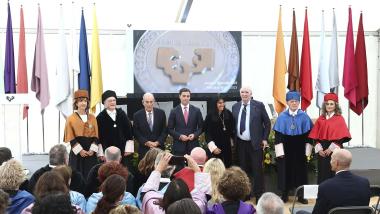Exploring Li-ion conductivity using atomistic simulations and effective medium theory
- The members of the Modelling and Simulation in Life and Materials Sciences group (MSLMS) led by Ikerbasque Professor E. Akhmatskaya at BCAM, in collaboration with CIC energiGUNE researchers, have published a high impact paper on the topic in Acta Materiala
Fossil fuel driven climate change has triggered a global effort to develop green technologies for energy storage. So far, rechargeable Li-ion batteries are alone at the leading edge, exhibiting the highest volumetric and gravimetric energy densities compared to available alternatives (fuel cells, Na-ion batteries, lead-acid, etc.) Yet, a significant increase in their storage capacity is hindered by the flammable and toxic organic liquid electrolytes that are in use today.
Garnet-structured Li7La3Zr2O12, a promising solid electrolyte for next-generation solid-state Li batteries, could be the solution to this hindrance. However, sufficiently fast Li-ion mobility required for battery applications only emerges at high temperatures, upon a phase transition from the tetragonal to the cubic structure. A well-known strategy to stabilize the cubic phase at room temperature relies in the substitution of Li+ by Al3+ ions. However, very large variations in conductivity have been reported at the same Al3+ concentrations, even for samples undergoing the exact same synthesis procedure.
For the first time, the atomistic origin of this phenomenon has been unveiled thanks to the advanced mathematical methods developed at the Basque Center for Applied Mathematics – BCAM (enhanced sampling Hybrid Monte Carlo methods, multi-stage integration schemes and optimized force fields). The members of the MSLMS group E. Akhmatskaya, F. A. García Daza and M. R. Bonilla, in collaboration with the CIC energiGUNE researcher J. Carrasco, have published the study Exploring Li-ion conductivity in cubic, tetragonal and mixed-phase Al-substituted Li7La3Zr2O12 using atomistic simulations and effective medium theory in the prestigious scientific journal Acta Materiala. In January, they had another paper on this topic published in the renowned scientific journal ACS Applied Materials & Interfaces.
Researchers found that Al3+ substitution in tetragonal LLZO allows previously inaccessible sites to become available, which enhances Li-ion conductivity. In contrast, in the cubic phase Li-ion diffusion paths become blocked in the vicinity of the Al3+ ions, resulting in a decrease in conductivity. By combining the conductivities of the individual phases through an effective medium approximation, they found that phase coexistence has a significant impact on the conductivity of Al-substituted LLZO.
Overall, the theoretical study and simulations of this work advance our current understanding of Li-ion mobility in Al-substituted LLZO garnets and might guide future in-depth characterization experiments of this relevant energy storage material.
Related news
Ikerketa




